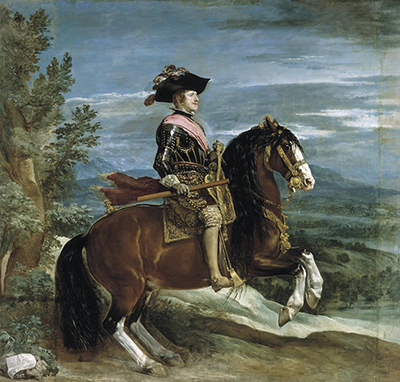Philip IV on Horseback
Philip IV and his family was captured by Diego Velazquez in many paintings and can be found here in a classic equestrian portrait.

This famous Spanish artist was well connected across Europe and received some high profile commissions in the latter part of his career. His subtle finishes put him at the front of the queue when the rich and famous required a new portrait. The subject here is portrayed in a powerful, confident pose. He appears to be about to charge from the front on his strong looking horse. Equestrian portraits like this help to contribute to a theme of war whilst adding to the aesthetic qualities of the painting as well. Artist Velazquez would continue this style with another notable commission, that of the Count Duke of Olivares. He would tailor every element of the portrait to match the subject, be it his attire, the type of pose chosen and the way in which he interacts with his horse.
There are very few drawings left from this artist's career but of those that do remain several display his study practices with regards the anatomy of the horse. In order to achieve the standard of accuracy that he did, constant practice and experimentation was necessary. The likes of Velazquez, Michelangelo and Leonardo da Vinci may have been geniuses, but that was not enough by itself. Horse portraits were common in the Baroque period, but famous paintings from more recent centuries include Horse by Pablo Picasso plus Large Blue Horses and Large Red Horses by Franz Marc. Many of the commissions supplied by Velazquez were used to decorate the stunning royal court of Philip IV of Spain, making it inevitable that he himself would want to be included in some of them, as well as his family.
Elisabeth of France was just 13 when the two married, a great example of how families and ruling powers would solidify their influence through marital agreements. Sadly, Elisabeth was to die young, a common problem during this time, and he would then marry again to the daughter of the Emperor Ferdinand, Maria Anna. Many of Velazquez's models would not survive long unfortuantely, meaning that visual records of them by court painters were especially important. In order to ensure the survival of the heir, many would have very large families to account for the high rate of infant mortality. Politically, the children would also often be vulnerable to those seeking power and so they were constantly in need of protection.